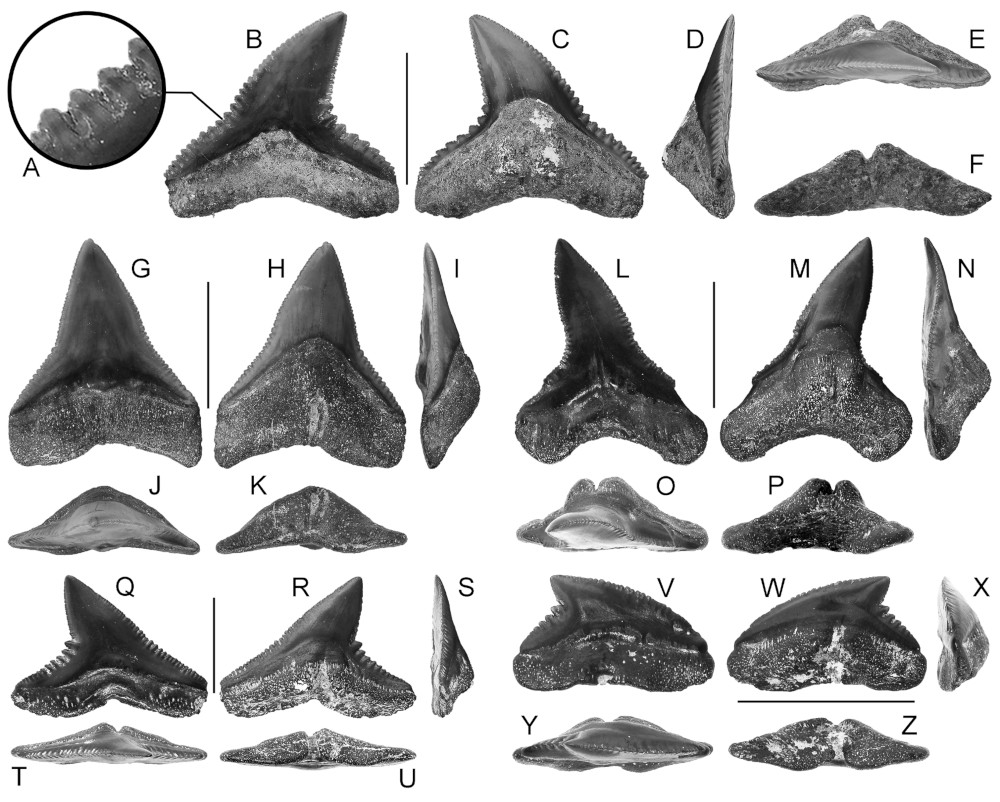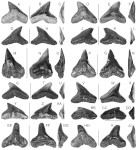Carcharhinus mancinae
Ebersole, Cicimurri & Stringer, 2019
Classification: Elasmobranchii Carcharhiniformes Carcharhinidae
Reference of the original description
Taxonomy and biostratigraphy of the elasmobranchs and bony fishes (Chondrichthyes and Osteichthyes) of the lower-to-middle Eocene (Ypresian to Bartonian) Claiborne Group in Alabama, USA, including an analysis of otoliths. European Journal of Taxonomy, 585, 1–274
Taxonomy and biostratigraphy of the elasmobranchs and bony fishes (Chondrichthyes and Osteichthyes) of the lower-to-middle Eocene (Ypresian to Bartonian) Claiborne Group in Alabama, USA, including an analysis of otoliths. European Journal of Taxonomy, 585, 1–274
Types
Carcharhinus mancinae
Holotype: MSC: 39036; Paratype: MSC: 39037; MSC: 39038; MSC: 39040; MSC: 39041;
Carcharhinus mancinae
Holotype: MSC: 39036; Paratype: MSC: 39037; MSC: 39038; MSC: 39040; MSC: 39041;
Description:
Citation: Carcharhinus mancinae Ebersole, Cicimurri & Stringer, 2019: In: Database of fossil elasmobranch teeth www.shark-references.com, World Wide Web electronic publication, Version 12/2025
Please send your images of "Carcharhinus mancinae" to info@shark-references.com

Carcharhinus mancinae sp. nov. A–F. MSC 39036, holotype, upper right lateral tooth; G–K. MSC 39037, paratype, upper left anterior tooth; L–P. MSC 39040, paratype, lower right anterior tooth; Q–U. MSC 39041, paratype, lower right lateral tooth; V–Z. MSC 39038, paratype, upper left posterior tooth, Scale bars = 1 cm © Ebersole et al. (2019)

Carcharhinus mancinae sp. nov. A–F. MSC 39036, holotype, upper right lateral tooth; G–K. MSC 39037, paratype, upper left anterior tooth; L–P. MSC 39040, paratype, lower right anterior tooth; Q–U. MSC 39041, paratype, lower right lateral tooth; V–Z. MSC 39038, paratype, upper left posterior tooth, Scale bars = 1 cm © Ebersole et al. (2019)
Description
Original diagnosis after Ebersole et al. (2019) p. 68 [27789]: This species can be differentiated from most other Claiborne Group chondrichthyans by the presence of compound and/or double serrations, which are absent on all taxa except Galeocerdo clarkensis White, 1956 and Otodus (Carcharocles) sp. Further separated from the carcharhiniforms Abdounia Cappetta, 1980, Galeorhinus, Hemipristis, Negaprion, Pachygaleus, and Physogaleus by the presence of fine mesial and distal serrations that extend to the apex of the main cusp. Differentiated from Galeocerdo clarkensis by the presence of erect and triangular upper anterior teeth, lower lateral teeth with a narrower and more erect crown, uniformly concave distal cutting edge with compound serrations medially, and lateral teeth have a more pronounced and ‘pinched’ lingual root protuberance. This species is separated from the following Paleogene Carcharhinus sensu stricto Underwood & Gunter (2012) species: the lower Lutetian Carcharhinus marçaisi from northern Africa (Arambourg 1952) by having serrated cutting edges; the middle Eocene Carcharhinus sp. from Jamaica (Underwood & Gunter 2012), the middle-to-late Eocene Carcharhinus sp. from Egypt (Underwood et al. 2011), and the middle-to-late Eocene Carcharhinus underwoodi and Carcharhinus sp. from Madagascar (Samonds et al. 2019) by having compound and/or double serrations and a more ‘pinched’ and pronounced lingual root boss; the Priabonian Carcharhinus balochensis from Pakistan Adnet et al. 2007 by having a less concave distal cutting edge, shorter and mesiodistally thinner crown in all anterior and lateral tooth positions, and pointed (as opposed to rounded) serrations on the lower two-thirds of the crown; and the Chattian Carcharhinus perseus Adnet et al., 2007 by having compound serrations and mesiodistally narrower crown in all tooth positions.
Original diagnosis after Ebersole et al. (2019) p. 68 [27789]: This species can be differentiated from most other Claiborne Group chondrichthyans by the presence of compound and/or double serrations, which are absent on all taxa except Galeocerdo clarkensis White, 1956 and Otodus (Carcharocles) sp. Further separated from the carcharhiniforms Abdounia Cappetta, 1980, Galeorhinus, Hemipristis, Negaprion, Pachygaleus, and Physogaleus by the presence of fine mesial and distal serrations that extend to the apex of the main cusp. Differentiated from Galeocerdo clarkensis by the presence of erect and triangular upper anterior teeth, lower lateral teeth with a narrower and more erect crown, uniformly concave distal cutting edge with compound serrations medially, and lateral teeth have a more pronounced and ‘pinched’ lingual root protuberance. This species is separated from the following Paleogene Carcharhinus sensu stricto Underwood & Gunter (2012) species: the lower Lutetian Carcharhinus marçaisi from northern Africa (Arambourg 1952) by having serrated cutting edges; the middle Eocene Carcharhinus sp. from Jamaica (Underwood & Gunter 2012), the middle-to-late Eocene Carcharhinus sp. from Egypt (Underwood et al. 2011), and the middle-to-late Eocene Carcharhinus underwoodi and Carcharhinus sp. from Madagascar (Samonds et al. 2019) by having compound and/or double serrations and a more ‘pinched’ and pronounced lingual root boss; the Priabonian Carcharhinus balochensis from Pakistan Adnet et al. 2007 by having a less concave distal cutting edge, shorter and mesiodistally thinner crown in all anterior and lateral tooth positions, and pointed (as opposed to rounded) serrations on the lower two-thirds of the crown; and the Chattian Carcharhinus perseus Adnet et al., 2007 by having compound serrations and mesiodistally narrower crown in all tooth positions.
References

A new Bartonian elasmobranch assemblage from the Kutch Basin, western India, and its significance in the context of paleoclimate change. Historical Biology, 36(10), 1985–2008
DOI: 10.1080/08912963.2023.2238736
Combining palaeontological and neontological data shows a delayed diversification burst of carcharhiniform sharks likely mediated by environmental change. Scientific Reports, 12, Article 21906
DOI: 10.1038/s41598-022-26010-7
Additions to the elasmobranch assemblage from the Bandah Formation (middle Eocene, Bartonian), Jaisalmer District, Rajasthan, India, and the palaeobiogeographic implications of the fauna. Palaeovertebrata, 44(2), Article e1
DOI: 10.18563/pv.44.2.e1
Taxonomy and biostratigraphy of the elasmobranchs and bony fishes (Chondrichthyes and Osteichthyes) of the lower-to-middle Eocene (Ypresian to Bartonian) Claiborne Group in Alabama, USA, including an analysis of otoliths. European Journal of Taxonomy, 585, 1–274
DOI: 10.5852/ejt.2019.585

A new Bartonian elasmobranch assemblage from the Kutch Basin, western India, and its significance in the context of paleoclimate change. Historical Biology, 36(10), 1985–2008
DOI: 10.1080/08912963.2023.2238736
Combining palaeontological and neontological data shows a delayed diversification burst of carcharhiniform sharks likely mediated by environmental change. Scientific Reports, 12, Article 21906
DOI: 10.1038/s41598-022-26010-7
Additions to the elasmobranch assemblage from the Bandah Formation (middle Eocene, Bartonian), Jaisalmer District, Rajasthan, India, and the palaeobiogeographic implications of the fauna. Palaeovertebrata, 44(2), Article e1
DOI: 10.18563/pv.44.2.e1
Taxonomy and biostratigraphy of the elasmobranchs and bony fishes (Chondrichthyes and Osteichthyes) of the lower-to-middle Eocene (Ypresian to Bartonian) Claiborne Group in Alabama, USA, including an analysis of otoliths. European Journal of Taxonomy, 585, 1–274
DOI: 10.5852/ejt.2019.585



















